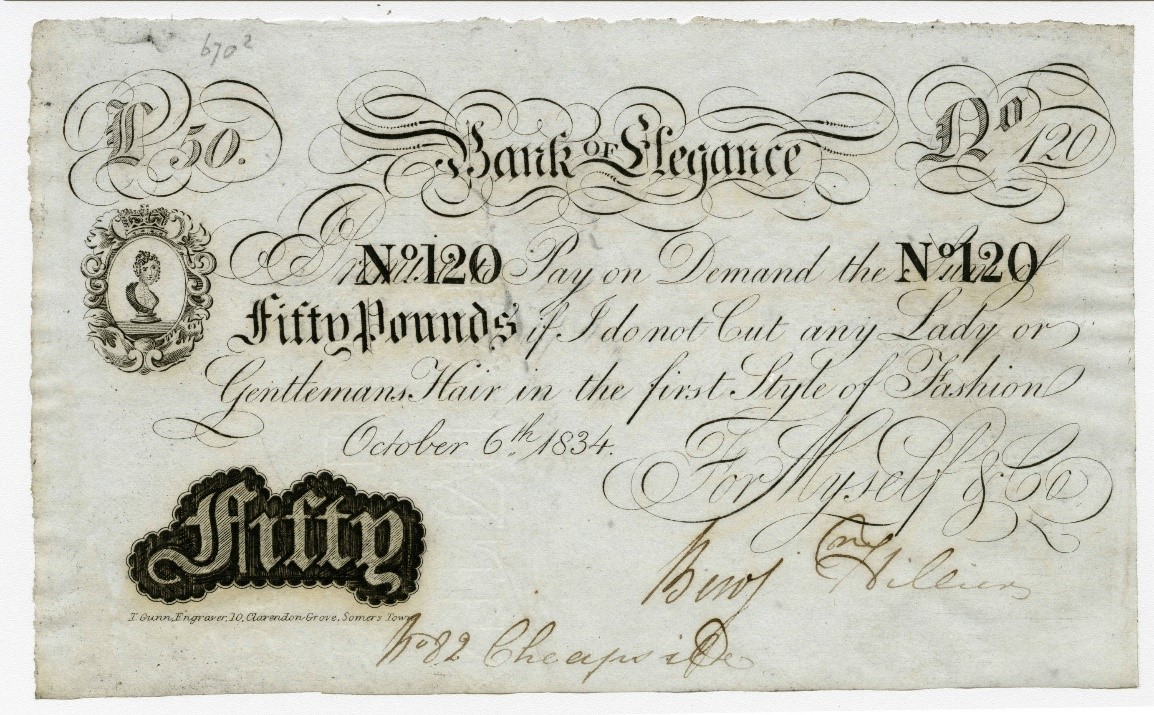This 'Bank of Elegance' flash note is from 1834. It says the owner of 22 Cheapside will 'pay on demand the sum of fifty pounds if I do not cut any lady or gentleman's hair in the first style of fashion'.
According to the trusty Bank of England inflation calculator, £50 in 1822 is equivalent to nearly £6,500 today. Clearly, Benjamin Hillier was pretty confident he would be able to satisfy his clients.
In the place you’d usually see Britannia is a vignette of a women with impressive hair. Based on that, you’d definitely be coming out of the salon with a pretty fab new do!
If you read my post on the Bank of the Great Wizard of the World, you'll know we have a large collection of flash (or ‘skit’) notes. These are counterfeit notes designed to look like real money, but not to be used as currency. Essentially, they're parodies of real notes.
Flash notes are often used to make a political statements (we’ve got one that George Cruikshank designed in protest against the death penalty in the 1800s). Or as adverts (we have one from the Bank of Hymen advertising a brothel in the 1800s, and another from sandwich chain Itsu).
I was intrigued by the Bank of Elegance note so I’ve been doing some digging to find out more about it.
The first thing I found out was that the Bank of Elegance was not, as I'd first thought, the name of a Benjamin Hillier's hairdressing shop.
In fact, Bank of Elegance notes promising discounts or guarantees of good service at hairdressers were made in bulk by engravers throughout the 19th century. This one is signed by 'I Gunn, engraver, 10 Clarendon Grove, Somers Town'.
These notes were sold to individual businesses, who could customise them with their own name and address. They usually signed them as if they were the Chief Cashier (as shown above).
The second thing I found out was that lots of these Bank of Elegance notes were made. I checked records of specialist auctions and the catalogues of a few other museums. It seems like loads of the notes survived. So it’s very likely that huge quantities were printed throughout the 19th century.
The third thing I found out was that Bank of Elegance notes quickly became synonymous with crime.
In 1845 the popular magazine of the day, Punch, covered the phenomenon. It claimed crime connected to Bank of Elegance notes was 'one of the chief topics of conversation in the City today'.
Although they weren't made to intentionally deceive people, imitating banknotes was still forgery and technically against the law. Despite this, I couldn't find any examples of the Bank of England taking a case against an engraver for producing Bank of Elegance notes. But they did write warning letters to engravers and confiscate their printing plates.
There was a good reason for these warnings and confiscations. Flash notes like these were often used to commit crime. Criminals would mix them up in wads of genuine notes. Or flash them under a vendor’s nose so they couldn't get a good look at them.
I guessed the sheer number of Bank of Elegance notes around at the time meant this could have happened regularly.
So I searched the British Newspaper Archive and the records of the Old Bailey to see if I could find many examples of people being taken in by the notes.
Sure enough, there were hundreds! Swindlers used them instead of genuine notes. They were used to bribe voters in local elections. And there were even cases of unsuspecting (and disappointed) pickpockets stealing them.
We might not think these notes look very convincing today. But if you think about how low literacy rates were in 1800, it becomes less surprising. Only 60% of males and 40% of females could read (although these rates did improve throughout the century).
At the same time, Britain's economy was developing rapidly. More transactions were taking place and there were more banknotes in circulation than ever before.
If you couldn't read, and were pretty new to handling banknotes, it would be fairly easy to mistake these for the real thing.
Let's get back to Benjamin Hillier.
Unfortunately, I didn't find out too much about him. He's listed in trade directories as a hairdresser and perfumer at a variety of addresses around Cheapside in the 1830s and 40s, and in Clerkenwell in the 1850s.
I wonder whether he knew his chosen advertising materials were so closely associated with such immoral purposes…

